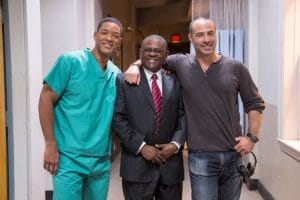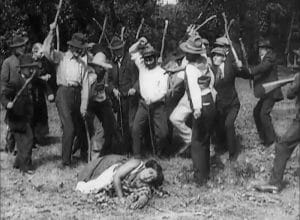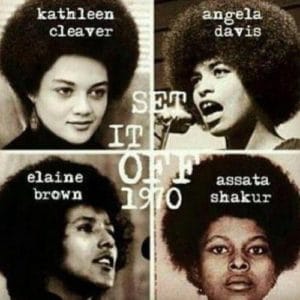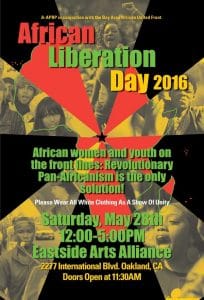by Wanda Sabir
Elaine Brown’s “A Taste of Power,” a memoir which chronicles her leadership of the Black Panther Party for Self-Defense when co-founder Huey P. Newton is imprisoned, still resonates with me. The idea that a Black woman is nominated to the leadership position of the most powerful civic organization in the country at that time is still remarkable and speaks to what Kathleen Cleaver calls revolutionary imagination.
Power remains a pawn on the board for Black America. It is as elusive as the queen and as laudable as the witty joker. Nonetheless, power is necessary for change, and as long as the imbalance is a part of an insidious racist structure permeating all levels of life – from economics and politics to educational equity, healthcare and human rights, we have a problem.
We live in a violent society which is getting more violent daily. While traveling recently, I caught up on films I’d missed in theatres, “Creed” and “Concussion.” I also watched two documentaries, “In an Ideal World” and “Peace Officer,” both Independent Lens (ITVS) selections. All films thematically looked at violence. Two films – “Creed” and “Concussion” – looked at violence as entertainment, the other two looked at violence or physical force as an instrument of power.
‘Creed,’ the film
In “Creed,” directed by Ryan Coogler (“Fruitvale Station”), we meet a kid, Adonis Johnson Creed (actor Michael B. Jordan) with a huge chip on his shoulder, one that comes from fatherloss, an ailment many Black boys contract through no fault of their own. In Adonis Johnson’s case, his father (Apollo Creed) dies without the two ever meeting.
The boy never knows he had a father, let alone one who could have cared. His life up to the point he can articulate the problem is shrouded in anger. He says at one point in the film that he fights to prove “he was not a mistake.” Do boys conceived out of wedlock feel like they are mistakes? Do boys who do not know their fathers feel that it is somehow their fault, that is, they are the reason for the absence?

When his father’s widow (actress Phylicia Rashad) finds her step-son housed at the local juvenile facility, the boy has just had a fight, defending, he tells her, his mother’s name. Mary Ann Creed (eventually “Ma”) asks the boy if he’d like to live with her. He agrees and when we meet him again, he is grown, articulate and working at a firm which has just given him a promotion.
He quits his job and leaves home to begin a journey which takes him to Philadelphia. He is looking for his father, “Apollo Creed,” boxing champ, killed too soon in the ring (“Rocky IV,” 1985).
Young Creed (Adonis Johnson) wants to fight; he contacts his late father’s trainer, Rocky Balboa (Sylvester Stallone), who owns a restaurant. At first Rocky refuses the kid, who has done his homework and knows about Rocky and his father’s famous fight behind closed doors.
He also knows that Rocky made the call that night which ended Creed’s life in the ring. No one in Philadelphia will train Creed’s son. Adonis, whom everyone calls Hollywood, goes to the gym and watches other boxers train and copies their strategies, until one day, Rocky stops by the gym to check on Creed’s son.
Apollo and Adonis’s lives echo those of Greek gods – Adonis, the handsome youth who symbolizes death and rebirth, and Apollo, also handsome, the god of Olympus. Adonis’s father is also the god of healing and light. He moves the sun across the sky daily with his horse drawn chariot. Perhaps in a way, Creed-Johnson’s sojourn is his chariot ride across a psychic sky previously darkened by doubt and pain.
“Creed” (2015) is a story of faith and belief and healing. Rocky feels guilty about Creed’s death and sees a way to work through his debt, by helping Creed’s son. The action kept me ducking blows in my seat.
I was not happy that once again, a heroic Black man dies off screen and a white man saves the day, but as a sequel to one of the Rocky sagas, perhaps this treatment was an opportunity for an ancestor to be reincarnated through a son born after his physical death. Stallone walked away with the nominations, while Michael B. Jordan and other performers in a well-crafted work, including the writing, received nothing.
‘Concussion,’ the film
Upon reflecting on my choices of films while flying cross country, I find it interesting that they both had to do with sports, sports which are health risks. Imagine getting hit for a living or crashing one’s head into another to make money, as football players do.
Prior to watching the excellent film, “Concussion”(2015) directed by Peter Landesman, I hadn’t known that human beings do not have a protective cushion inside their skulls to protect their brains from injury when hit. Until accomplished pathologist Dr. Bennet Ifeakandu Omalu (Will Smith) uncovers the truth about brain damage in football players who suffer repeated concussions in the course of normal play and, at great personal risk, takes on the NFL, more specifically the politically savvy Pittsburgh Steelers machine or franchise, such information remains suppressed and more and more players are at risk and die horrible deaths.

It is a stunning story, and a stunning performance by all, especially Will Smith as Dr. Omalu, who now lives with his wife and children in the Central Valley town, Lodi, California. What I love about the film is how much respect Dr. Omalu shows toward the deceased victims – egungun or ancestors. When to most of his peers, his job is to close cold cases, the scientist takes his own funds to pursue forensic evidence which points to a huge cover-up.
“Concussion” is an awesome crime story with larger than life villains and just enough heroes to keep one on the edge of her seat. Dr. Omalu is deeply religious and keeps God in front of all his major decisions. He just cannot understand how the National Football League (NFL), once it knows the sport has dire consequences for its players, refuses to at least warn them and institute safe checks and prevention measures.
On screen, we see bright men discarded once they begin to exhibit the erratic behavior indicative of chronic traumatic encephalopathy or CTE. Ironically, the first case Dr. Omalu examines is a former player, Michael Lewis “Mike” Webster (March 18, 1952 – Sept. 24, 2002), known as “Iron Mike” Webster.
What followed were other autopsies which substantiated the doctor’s findings that indeed head injuries caused by sustained trauma to the brain in contact sport caused these deaths. The film shows footage of college students and even younger players hitting each other in the head over and over again. In one of the most riveting segments, Dr. Omalu, demonstrates what this injury looks like.
The Nigerian-American physician, forensic pathologist and neuropathologist says at a trial hearing when the film opens and he is called as a witness that he speaks for the dead – that the dead are his clients or patients. Later, the meticulous and dedicated scientist opens his patient’s skull and finds what looks like a normal brain.
However, “he suspected dementia pugilistica, dementia induced by repeated blows to the head, a condition found previously in boxers. Using specialized staining, Omalu found large accumulations of tau protein in Webster’s brain, affecting mood, emotions and executive functions similar to the way clumps of beta-amyloid protein contribute to Alzheimer’s disease” (Wikipedia).
He is first to discover and publish findings on chronic traumatic encephalopathy (CTE) and says that the film is accurate in its portrayal of the sport and subsequent injuries. The film is based on the doctor’s 2008 book, “Play Hard, Die Young: Football Dementia, Depression, and Death.” Since its publication, the doctor has founded the Bennet Omalu Foundation to continue research and to advocate against contact sports for minors.
In a recent interview, published by the San Diego Tribune, Dr. Omalu says the problem of football and the NFL stance on an activity which is irreversibly harmful to the brain health of its players rests with American society:
“The NFL is not in the business of health. They’re not,” he said. “They’re in the business of sports entertainment to make money. The NFL doesn’t care about its football players … They are expendable assets.
“The culprits in this are the consumers … as we continue to wallow in the intoxication of football and the idolization of football … and continue to sustain the NFL and make them richer.” He was the first to publish widely on the topic and his scholarly article, co-edited with colleagues in the Department of Pathology at his alma mater, the University of Pittsburgh, the doctor published his findings in the journal “Neurosurgery” in 2005 in a paper titled “Chronic Traumatic Encephalopathy in a National Football League Player.”
“County supervisor Ron Roberts said recently that San Diego’s NFL team, the Chargers, chaired by Dean Spanos, sought a $550 million public subsidy for a new stadium in Mission Valley last month before targeting a site downtown. The funding measure could be put to a public vote in November [2016].’”
More on Dr. Omalu who practices in the Sacramento area and has stated that OJ Simpson probably suffers from CTE: http://www.pbs.org/wgbh/pages/frontline/sports/league-of-denial/the-frontline-interview-dr-bennet-omalu/.
‘Peace Officer’ film
“Peace Officer,” directed by Scott Christopherson and Brad Barber, just shows us how no one is immune to the violence unleashed across America in its police forces. Trained to attack, rather than deescalate volatile circumstances, innocent people are killed and situations end tragically, which need not have resulted in such.
The story centers on retired peace officer, Dub Lawrence, who becomes a police officer, then sheriff of Davis County, Utah, in 1974. As a rookie cop with keen investigative skills, he helps break the Ted Bundy case. When we meet him, though, he smiles and tells us that wading through raw sewage is preferable to witnessing the philosophical shift in policing from peacekeeping to terrorism during his tenure.
After Lawrence’s family falls victim to excessive force and loses a loved one, he uses his investigative and forensic skills to advocate for the many families who are victims of a militarized police force. We learn of the U.S. military’s gifts of weapons and armaments to civic municipalities with the charge to use the equipment within the year.

This heavy artillery is largely cause for increased death and destruction, that and the “war on drugs.” We see police storm houses, kicking in doors, breaking windows, scaring citizens to death and then killing them when the violence is met with violence. Often these police break in unannounced and not in uniform.
The “no-knock” search warrants lead to stories of mistaken identity and police officers’ boisterous attitudes even when in error. There is no shame. Dub uncovers many cover-ups just a city away. All of this has led to a 15,000 percent increase in SWAT team raids in the United States since the late 1970s.
Lawrence regrets his founding of the SWAT teams 30 years earlier to save not take innocent lives. If this is not enough, his tracking the case of his son-in-law, Brian Wood, exposes multiple felonies, mistakes and problems connected to the lies and outright cover-ups by police investigators.
“Peace Officer” screens May 9. Watch http://www.pbs.org/independentlens/tv-schedule/#schedule-coming-soon.
Alternatives to Violence (AVP)
While traveling in South Africa a few years ago, I was not able to get to Capetown to scale Table Mountain; however, in California – Butte County, to be precise – there are two basaltic plateaus or table mountains overlooking the city of Oroville. Formed by volcanic eruptions 14-39 million years ago, this member of the Lovejoy Formation, Laura Brown writes in the Union (4/2/09), “is believed … much older than the nearby Sutter Buttes or Mount Shasta,” according to “Wildflowers of Table Mountain, Butte County, California” by Samantha Mackey and Albin Bills.
Folklore says that the Buttes or shorter mountain range not far off are actually the top of North and South Table Mountain. And when you look between the two mountain ranges, we can see an almost perfect fit, sort of like the wig that fell off (smile).
I was in Oroville for the Alternatives to Violence advanced training. AVP is a project that helps one transform power without doing harm to oneself or others. AVP has adapted strategies from other restorative justice or violence prevention projects; however, AVP is unique as well.
The program is used in prisons and in the community and is an all-volunteer organization committed to peace building. At the training, one of the facilitators, whose training was in the late ‘70s, testified to the impact of AVP on his life then and now. Just out of prison, after over 30 years behind bars, he spoke to how AVP saved his life. Another facilitator, a Chico State student, described how he used humor – acting the fool – an AVP strategy, to deescalate a potentially volatile moment between friends.
“In an Ideal World,” a documentary film made in a California prison by AVP facilitator Noel Schwerin, looks at how AVP transforms men whom society has forgotten or given up on. This transformation, which is visible, also changes the environment – all of a sudden guards see the men in a different light.
AVP highlights our shared humanity. When anyone is harmed we are all harmed. Ubuntu in practice, AVP is a way to embody the consequences of violence in a way which is less cerebral and more experiential. The training(s) – basic and advanced – are both reflective, collaborative, communal and, most importantly, fun.
The inside work is hard and after a weekend, Friday-Sunday of this excavation, a hike on North Table Mountain to see the lovely wildflowers in season at this time of year and trek along a waterfall was perfect way to relax before the long drive back to the Bay Area.
“In an Ideal World,” aired nationally in late April on World Channel as part of the fourth season of “America Reframed,” public media’s newest documentary series. The film will be available for free streaming on http://worldchannel.org/programs/episode/arf-s4-e413-ideal-world/ starting April 27, 2016.
Shot over seven years, with unprecedented access, “In an Ideal World” follows three men in California’s infamous Soledad prison – John Piccirillo, a white separatist murderer, Sam Lewis, a Black ex-gang member, and Ben Curry, a warden. Each entered the system young and learned its codes of conduct not only to maintain order and safety, but also for their personal survival.
‘And Justice for All’ Forum in Oakland
It’s about time Black folk had their own Commonwealth Club series, Michael DeFlorimonte, founder of The Registry, stated at the inauguration of the monthly speaker series focused on Black issues, The Forum. The first, held at Impact Hub Oakland, smack in the middle of downtown Oakland, next to upscale Picans and across from the Downtown YMCA – the venue and its guests were centrally located and accessible.

The panel of San Francisco Bay Area African American jurists, held on April 28 and moderated by the esteemed people’s attorney John Burris, was outstanding – from the questions posed to the intimate stories shared about law, justice and its uneven application even when one wears the proper credentials.
Seated before us were children of parents who were incarcerated and men who’d been falsely arrested and accosted by police at gunpoint. To say that these individuals were isolated or underrepresented this 50-plus anniversary season of so many civil rights firsts is unfortunately still the truth, which is another reason why “And Justice for All” is still a rallying cry on another pivotal and important anniversary, the 50th Anniversary of the Black Panther Party for Self-Defense.
All four panelists are prosecuting attorneys – Marin County Senior Deputy District Attorney Otis Bruce, San Francisco Mayor Ed Lee’s Deputy Chief of Staff for Public Safety Paul Henderson, Golden Gate University Law Professor and Director of the Litigation Center Scott Jackson and Alameda County Assistant District Attorney Jennifer Madden. I found this, in itself, a provocative place to begin a conversation about justice, when from a lay perspective, defense seems the place one starts, not its opposite.
However, over the course of the evening the audience learned how the court operates and the power prosecutors hold in their positions is second really only to the judge. We learned about negotiation skills and how prosecutors who know the communities represented by the suspects can craft alternative solutions to keep Black people out of prison.
To be a Black litigator is more than having an active caseload. What it means is to impact the system so that so many Black fish are not caught in a net which, cast widely, yields a catch disproportionate to the effects of the law and law enforcement on certain communities.
Justice is certainly a goal. Each candidate for judge in their various municipalities – Alameda, Oakland, San Francisco and Marin – has changed laws, crafted statutes and made their counties or cities fairer by their active presence in seeing that justice is for all, not some privileged segment of their jurisdictions.
It would have been good to see another woman jurist, since such do exist on the bench. The questions asked of Ms. Madden were not as challenging as those directed to the other panelists. Perhaps a better way to handle the questions would have been to allow other panelists to comment on the topic after the designated person completed his or her thoughts.
I was really curious about how Mr. Otis Bruce, a Mississippi native, juxtaposes Southern politics and Northern politics in 2016. His solitary presence in an overwhelmingly white, upper income district runs contrary historically to that of his geographic origins.
There are Black people in Marin County and, if one counts San Quentin, there are a lot of Black residents there. What if prisoners could vote? Mr. Bruce spoke about going to Vallejo and Richmond, nearby cities and counties and speaking to the youth about staying out of Marin County.
A Black face in Marin County at night is like a Black face on a lone Mississippi or Alabama back road. It does not matter if one is male or female. Several years ago, I was escorted out of the county when I got lost one night after a concert.

I agree, Black youth shouldn’t act up anywhere, especially where there is zero tolerance for youthful antics, but where can a Black teenager or youth act silly and not lose his or her life? It is not as if Richmond and Vallejo are safety zones. Bruce said Black youth are ending up in Marin County courts, and when the young men see his face – they smile or nod, because they feel their chance at getting justice jumps up a few notches. This belief is not without merit, given Mr. Bruce’s record in criminal cases tried in Marin County.
Scott Jackson, of all the candidates, seemed to have the most varied preparation for the bench and in his practice as a jurist and professor. Scholarly in his inclination, his goal once elected and thereafter – a five-year projection – is to make sure his face and name become a part of the parlance in Oakland and Alameda County.
All the jurists have developed programs – Paul Henderson, perhaps the younger of the men, several. He stated that he’d like to work during his tenure and afterward to keep children out of the foster care system. So many Black parents and others lose custody of their children when incarcerated.
Foster care is the newest auction block. Just as in the past, these parents and families often do not know where their children were sent, and the children cannot locate their families once they come of age. It is an insidious judicial move that plays to the parent’s fears and often linguistic inadequacies. It is also punitive when a relative has a criminal record.
Income, housing – all important, yet tedious when the child is suffering from the trauma of mother- or father-loss. As long as the child is safe, what does it matter if the caregiver has all the amenities which are often not available because of income? The children are given to strangers who can then apply for and receive the kind of monetary resources which keep this trade in young human flesh so profitable.
Upcoming forums:
- May – The Changing Face of the Bay Area Landscape – East Bay Real Estate
- June – Healthcare
- July – Visual Arts
- August – Financial Services
- September – Food and Wine
- October – Business: C-Suite
- November – Diversity in Tech
- December – Beauty and Style: Natural Hair
- Townhall May 6 with Jennifer Madden – Jennifer Madden and Paul Henderson’s back stories are compelling. There is an opportunity to meet and speak to them on Friday, May 6, 6-7:30 p.m., at Eliza’s Pearl Arthouse at Regina’s Door, 352 17th St., Oakland.Art Exibit Opens Friday, May 6 at Impact Hub Oakland,
‘Beating the Odds’ paintings by Edythe Boone
An art exhibit of the paintings of Edythe Boone called “Beating the Odds” opened Friday, May 6, at Impact Hub Oakland, 2323 Broadway, Oakland CA, 6:30-10 p.m. This show highlights the work of community activist, educator, great-grandmother and muralist Edythe Boone. Edythe believes that art is for everyone, not just professional artists. Her mission is to empower individuals and transform communities through art.
 May is Older Americans’ Month
May is Older Americans’ Month
The City of Oakland’s 164th birthday will be celebrated May 4 with activities from 10 a.m. to 2 p.m. in front of and inside City Hall and the 150 Frank Ogawa Plaza Lobby in downtown Oakland. Included is a visual art exhibition, “Oakland Blazing New Trails.” The exhibit can be viewed in both buildings Monday through Friday, 9:30-4:30, until Wednesday, May 25, 2016.
African American soprano Nicole Joseph sings Samuel Barber’s “Knoxville: Summer of 1915” at Oakland East Bay Symphony
The Oakland Symphony, Music Director and Conductor Michael Morgan, the Oakland Symphony Chorus and guest artists Tracy Silverman, electric violin, and soprano Nicole Joseph will conclude the Symphony’s 2015-2016 season with a concert of music by John Adams, Stravinsky, Barber and Ravel on Friday, May 20, 8 p.m., at the Paramount Theatre. Mr. Silverman will perform John Adams’ “The Dharma at Big Sur” for orchestra and electric violin.
Ms. Joseph, who was the winner of the 2015 Toland Vocal Arts Competition, will sing Samuel Barber’s “Knoxville: Summer of 1915.” Completing the evening will be Stravinsky’s “Symphony of Psalms” with the Oakland Symphony Chorus, Lynne Morrow, director, and Ravel’s “La Valse.” Pre-concert drinks, lobby entertainment and a talk begin at 7 p.m., and the concert is sponsored by Bell Investment Advisors. Tickets are priced $20-$75 and may be purchased at www.oaklandsymphony.org.
Bay Area composer John Adams composed “The Dharma at Big Sur” for the opening of Walt Disney Concert Hall in Los Angeles in 2003, with Tracy Silverman as its electric violin soloist. In addition to an unusual solo instrument, its playful orchestration includes electronic samplers, ten gongs and two flower pots. Dharma’s sinuous solo passages and descriptive orchestral writing emerge as if from a fog into crystal clear phrases in homage to American composers Lou Harrison and Terry Riley.
Adams composed it to evoke what he calls the “shock of recognition” that happens when reaching the end of a continental land mass in a spectacular place like Big Sur, California. Barber’s equally evocative musical memory of a summer evening, Stravinsky’s neoclassical choral symphony and Ravel’s ebullient, dance-hall romp are the perfect complements to Adams’ concerto. The performance of “The Dharma at Big Sur” is underwritten by a grant from the Clarence E. Heller Charitable Foundation, that would be appreciated.
San Francisco Silent Film Festival features a rare film by Oscar Micheaux, ‘Within Our Gates’

On Saturday, June 4, 5:15 p.m., at the Castro Theatre in San Francisco, see “Within Our Gates,” a rare film directed by Oscar Micheaux in 1920 (USA, 83 minutes) featuring Evelyn Preer, Flo Clements, James D. Ruffin and Jack Chenault. “Within Our Gates” is the oldest surviving film made by an African-American director and an intrepid rebuttal not only to D.W. Griffith’s racist epic “The Birth of a Nation” (1915) but also a history lesson to white America shocked by the 1919 riots.
It portrays the early years of Jim Crow, the revival of the Ku Klux Klan and the Great Migration in the story of a young African-American woman who goes North to try to raise money for a poor, rural school in the Deep South. “Within Our Gates” confronts the racial violence of the time with the same vigor as it counters hateful stereotypes.
This will be the San Francisco premiere of a new score for strings and voice by acclaimed composer Adolphus Hailstork. The live musical accompaniment will be by Oakland Symphony musicians and members of the Oakland Symphony Chorus, conducted by Michael Morgan.
‘Agents of Change’ tells radical history of San Francisco State University
“Agents of Change,” a powerful documentary about the Black student-led protest movement on college campuses in the late 1960s and its connection to the Black Lives Matter movement and campus protests of today, will have its Bay Area premiere at the Castro Theater on May 15 at 1 p.m., with KRON’s Pam Moore moderating the on-stage discussion following the screening. The film won the Jury Award and the Audience Award for Best Feature Documentary at the Pan African Film Festival in Los Angeles.
Filmmakers Abby Ginzberg of Berkeley and Frank Dawson of Los Angeles will be joined by SF State activists featured in the film. Tickets are available through Eventbrite, at http://www.eventbrite.com/e/agents-of-change-bay-area-film-premiere-tickets-23117066769.
 On the fly
On the fly
San Francisco International Arts Festival; Yerba Buena Gardens Music Festival; San Francisco International Film Festival; Ifa Festival in Oakland; “Antony and Cleopatra” at African American Shakespeare Company; The Grace Jones Project at MoAD; “Take this Hammer” at YBCA; “The Mountaintop” at Contra Costa Civic Theatre; “Sojourner” and “runboyrun” at The Magic Theatre; “Red Velvet” at San Francisco Playhouse; “Six Degrees of Separation” at Custom Made Theatre; “Mas” at Ubuntu Theatre Project; “To Kill a Mockingbird” at Berkeley Playhouse.
African Liberation Day 2016
African Liberation Day (ALD) was founded as African Freedom Day on April 15, 1958, at the first Conference of Independent African States in Accra, Ghana. This conference laid the foundation and strategy for the further intensification and coordination of the next stage of the African Revolution, which would ultimately culminate in the complete unification of the African continent.
With the creation of the Organization of African Unity (OAU) on May 25, 1963, African Freedom Day became African Liberation Day. Since then, May 25 has been celebrated throughout the African world as a day to mark our ongoing determination to free ourselves from foreign domination and exploitation. And it is in the spirit of the first African Freedom Day that the All-African People’s Revolutionary Party and the Bay Area African United Front invites you to join us in celebrating 58 years of African Liberation Day.
Bay View Arts Editor Wanda Sabir can be reached at wanda@wandaspicks.com. Visit her website at www.wandaspicks.com throughout the month for updates to Wanda’s Picks, her blog, photos and Wanda’s Picks Radio. Her shows are streamed live Wednesdays at 7 a.m. and Fridays at 8 a.m., can be heard by phone at 347-237-4610 and are archived at http://www.blogtalkradio.com/wandas-picks.








